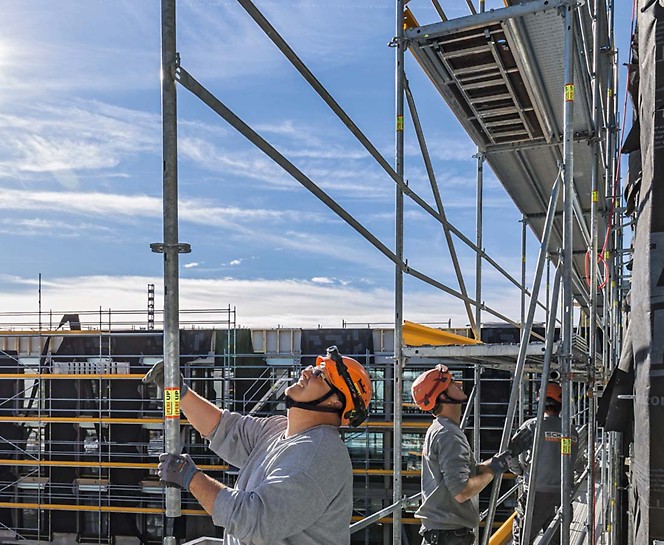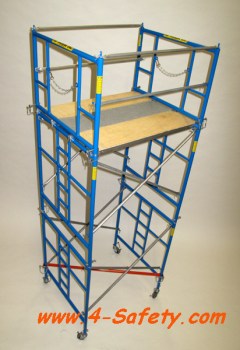Get the Best Scaffolding Cobham Services for Your Building Projects
A Comprehensive Guide to the Essential Attributes of Scaffolding in Modern Building And Construction
The landscape of modern-day building and construction progressively depends on efficient scaffolding systems that focus on innovation, efficiency, and safety and security. As projects expand in intricacy, comprehending the necessary attributes of scaffolding becomes vital for making sure worker safety and optimizing job timelines.
Sorts Of Scaffolding
Although scaffolding systems can vary extensively in layout and application, they generally come under numerous unique classifications that satisfy different construction demands - Scaffolding. One of the most typical types include sustained scaffolding, suspended scaffolding, and rolling scaffolding
Supported scaffolding includes platforms supported by a framework of posts, which offer a raised and stable working surface area. This kind is commonly utilized for tasks that call for substantial altitude, such as bricklaying or exterior paint.
Put on hold scaffolding, alternatively, is used for tasks requiring accessibility to high elevations, such as cleaning or fixing structure exteriors. This system hangs from a rooftop or an additional structure, allowing employees to lower or increase the platform as needed.
Rolling scaffolding attributes wheels that enable simple movement across a task website. It is specifically useful for jobs that call for frequent relocation, such as interior job in large areas.
Each kind of scaffolding is designed with particular applications in mind, ensuring that building tasks can be executed efficiently and successfully. Recognizing these categories is vital for picking the appropriate scaffolding system to meet both project requirements and website problems.
Secret Safety And Security Attributes
Safety is vital in scaffolding systems, as the possible threats linked with operating at heights can cause severe mishaps if not correctly taken care of. Trick security features are important to make sure the well-being of employees and the integrity of the construction site.
Firstly, guardrails are vital. These obstacles give a physical protect against drops, significantly reducing the danger of significant injuries. In addition, toe boards are usually made use of to stop tools and products from dropping off the scaffold, safeguarding workers listed below.
An additional essential component is the usage of non-slip surfaces on systems. This attribute improves grasp, specifically in negative climate condition, thus minimizing the chance of falls and slips. Access ladders must be securely placed to help with secure entry and exit from the scaffold.
Normal evaluations and upkeep of scaffolding systems are also essential. These evaluations make certain that all elements remain in good problem and working correctly, addressing any kind of wear or damage without delay.
Lastly, proper training for all workers associated with scaffolding operations is vital to make certain that they comprehend safety and security protocols and can determine possible dangers. Scaffolding. Collectively, these functions develop a safer working atmosphere and significantly reduce dangers associated with scaffolding
Material Advancements
Improvements in material science have dramatically affected the scaffolding sector, enhancing both safety and effectiveness in contemporary building. The intro of high-strength steel and light weight aluminum alloys has actually revolutionized conventional scaffolding systems. These materials are not only lighter, making them simpler to deliver and construct, yet also provide superior load-bearing capabilities. This leads to scaffolding frameworks that can support better weights while minimizing the threat of collapse.
Furthermore, ingenious composite materials, such as fiberglass-reinforced plastics, have become feasible choices. These products are resistant to corrosion and ecological deterioration, hence expanding the life expectancy of scaffolding systems, particularly in harsh climate problems. Making use of such materials contributes to decrease maintenance costs and makes certain consistent performance in time.


Layout Factors To Consider
Thinking about the intricacies of modern-day building projects, effective scaffolding layout is vital to guaranteeing both performance and security. Design factors to consider have to incorporate numerous aspects, including lots moved here capability, height, and the particular requirements of the building and construction site. Each project offers distinct challenges, demanding a versatile approach to scaffolding systems that can adjust to varying conditions.
Architectural stability is crucial; consequently, engineers need to determine the lots that the scaffolding will sustain, including employees, materials, and equipment. The selection of materials plays an essential duty in guaranteeing the scaffolding can stand up to these loads while continuing to be resilient and light-weight. Furthermore, the design needs to enable very easy access and egress, promoting the smooth motion of employees and materials.
Safety attributes, such as guardrails and non-slip surface areas, should be incorporated to lessen threats of crashes. Furthermore, the format needs to think about the surrounding environment, including potential dangers and surrounding structures. By attending to these layout factors to consider, building and construction companies can enhance the effectiveness of scaffolding systems and promote a safer working atmosphere, inevitably adding to the overall success of the project.
Maintenance and Inspections
The efficiency of scaffolding systems extends past first layout and execution; continuous upkeep and normal evaluations are important to ensuring their continued efficiency and security throughout the duration of a project. Regular assessments need to be performed by certified workers to determine any indications of wear, damages, or instability that might compromise the integrity of the scaffolding.
Upkeep procedures must consist of routine checks of structural components, such as frames, fittings, and slabs, guaranteeing that all elements continue to be protected and totally free from corrosion or various other wear and tear. Furthermore, the performance of safety attributes, such as guardrails and toe boards, need to be evaluated to make certain compliance with safety and security guidelines.
Documentation of all examinations and maintenance tasks is essential for accountability and regulative conformity. A methodical strategy to record-keeping not just aids in tracking the problem of the scaffolding however additionally supplies essential evidence in case of an occurrence.
Ultimately, developing a comprehensive maintenance and inspection timetable will significantly minimize the risk of mishaps and improve the total security of the building and construction redirected here site. By prioritizing these methods, building managers can protect employees and promote the project's stability.

Conclusion
Finally, the important features of scaffolding in modern-day building and construction encompass a range of essential components, consisting of diverse types, key safety and security systems, material innovations, see page and thoughtful design factors to consider. Highlighting security via guardrails and non-slip surface areas, together with advancements in products like high-strength steel, boosts both performance and sustainability. Regular upkeep and assessments are important for ensuring architectural integrity and safety on construction websites, ultimately assisting in efficient task implementation and promoting the wellness of workers.
The landscape of contemporary construction progressively relies on reliable scaffolding systems that focus on technology, efficiency, and security.Improvements in material scientific research have substantially affected the scaffolding industry, boosting both safety and security and efficiency in contemporary construction. In general, these material advancements not only enhance the performance and security of scaffolding systems yet also straighten with the sector's press in the direction of sustainability, as many contemporary products are developed to be a lot more eco pleasant.
Taking into consideration the complexities of modern building and construction projects, effective scaffolding design is critical to guaranteeing both performance and security.In verdict, the crucial functions of scaffolding in modern construction encompass a range of critical components, including varied kinds, vital safety systems, material advancements, and thoughtful style considerations.